This is a précis of an article by Woolgar, which was first published in 2010. However,
most of the copyright illustrations are no longer available. Therefore new illustrations
and additional material has and will be added as information comes to hand and researched.
Most recent update 18th November 2022
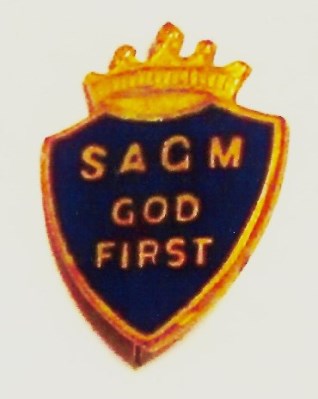
Edwardian 'S A G M' lapel pin badge
(South Africa General Mission)
Introduction
Addressed envelopes ('covers') to Mrs. Head were offered for sale by a London dealer, operating from premises in the Strand during the 1980s, who was possibly unaware of the importance of these covers to the philatelic history of the places from whence they came. Unfortunately, the letters had been removed from the covers mentioned here.
Our objective was to obtain information about Mrs. Head,1 why she received mail from southern Africa, the identity of the senders and whether the datestamps on the Swazieland2 covers represented the first point of entry into the postal system. As some covers had been annotated with abbreviations of senders’ names on arrival at Corrie Lodge, it was possible to identify most of them. Some covers were not annotated in this way, but by comparing the handwriting on these with those which were, the identities of the senders were reasonably established. It was then possible to broaden the research using the publications listed in the bibliography.
The first cover below is addressed to Corrie Lodge, Wimbledon, and, like all the covers mentioned in the list below, has been roughly opened. The full postal address was Corrie Lodge, 15 Lingfield Road, Wimbledon, Surrey, England, although the house number was not used by any of the correspondents on the covers seen to date.
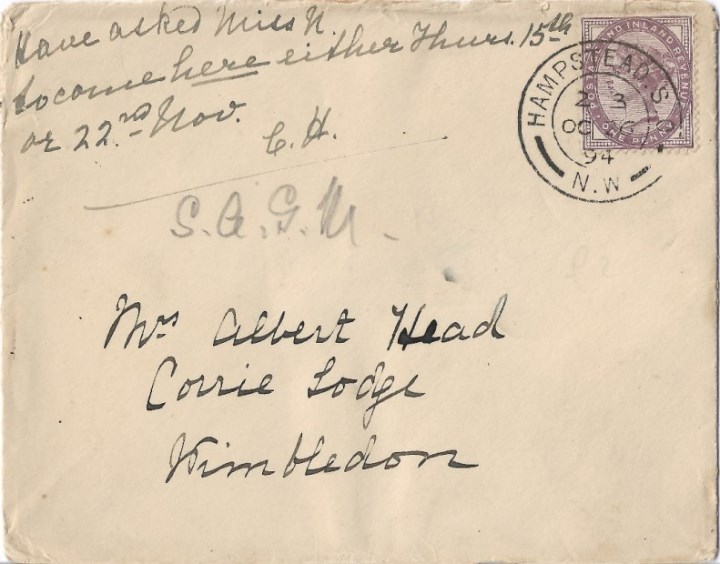
Figure 2 The cover here is from England and is addressed to 'Mrs Albert Head' at 'Corrie Lodge Wimbledon' and entered the post at Hampstead the on 26th of October 1894. It is an example of the way that mail was treated on arrival at Corrie Lodge. Opened roughly and annotated by Carrie Head, 'C.H.' and also 'S.A.G.M.' in pencil. The letter would have been filed in the envelope for future reference. Here the reply to the sender has been added in ink, suggesting two possible dates that were convenient for 'Miss K' to call.
Mrs. Caroline Head (née Hanbury) and Mr. Albert Alfred Head.
Caroline Hanbury, known to her family and friends as “Carrie”, born Stoke Newington, London, 14th November 1852, was from a family who were both affluent and deeply religious. Albert Head, born Suffolk 1844, is variously described as a wealthy merchant banker and marine insurance broker, known by the Hanbury family for many years. After the visit of American Evangelists Moody and Sankey to the North London Mission and his meeting with the former, “a great change had come over Albert Head” and he took an interest in Christian activities “instead of the life of gaiety and society” with which he had always been associated by the family. Caroline and Albert were married on the 15th February 1876 and spent their honeymoon in Paris and the South of France, subsequently living at various addresses in highly desirable parts of London. They had two sons, both of whom suffered ill health and a daughter who died at birth.
In 1889 they let their house in Richmond3 and moved to St. Leonards on Sea, Sussex, for their son Albert’s health and it seems likely that at this point they became associated with Dr. David Hoadley Gabb, MRCS, LSA, whose practice was nearby in Hastings (18, Wellington Square, Hastings). Unfortunately, their son Albert Hanbury Head died 14th January, 1892.4 Their other son, Alfred, later married Dr. Gabb’s youngest daughter in 1917.5 Another of Dr. Gabb’s daughters, Frances Georgina, became a missionary in Swazieland and her name is annotated on some of the covers.
Corrie Lodge, Wimbledon.
Caroline and Albert Head moved to Wimbledon in 1892 where later the South Africa General Mission6 an undenominational Christian union was close by. The object of the SAGM was “to evangelise the heathen, to rouse the Christian Church to a holier life and to aid existing missions and churches”.7 Apart from Caroline’s interest in missionary work, she was also asked to take meetings of the Postal Telegraph Christian Association and many other Christian organisations.8
Albert was on the Council of The Cape General Mission since its formation in 1889.9 Caroline interviewed women candidates who offered to go to Cape Colony as missionaries and they were invited to stay at Corrie Lodge. Later, when on station, she would correspond with them resulting in “masses of letters from the Cape”.10
In 1893 Albert was invited to visit mission stations of the Cape General Mission / South Africa General Mission.11 He accepted and Caroline accompanied him, despite being a poor sailor. They funded the journey themselves and sailed for South Africa in October of that year. At his Keswick Convention in Wellington, Cape Colony, they met and stayed with the President of The Cape General Mission, Rev. Andrew Murray (Jnr.), older brother of Miss. Helen Murray, whose name is annotated on one of the covers. On 29th October Caroline and Albert visited the Huguenot Seminary, Wellington, where they met Miss. Abbie Park Ferguson, whose name is annotated on one of the known covers. Here they found 120 girls under the tutelage of Miss Fergusson.
On Wednesday 1st November they arrived at Rondebosch where they stayed with Sir John Gordon Sprigg GCMG, (later Premier of Cape Colony, 13th January 1896 – 13th October 1898). Lady Sprigg ordered a carriage and pair that took them to ‘Hout’s Nek, a beautiful high pass between Table Mountain and other hills.’ Mrs. Head wrote, “The sea shone in the true African style, and the view from the top was most exquisite over the sea and False Bay and the blue mountains near Wellington.”
Later in November they were in Pretoria where Caroline went shopping with Miss. Clara Harris, whose name is annotated on covers illustrated on this website, “and was delighted to help her and Miss. Gabb towards setting up housekeeping in the wilds of Swazieland. After dinner went to Mr. Coates to see the huge waggon being loaded with all their furniture, and a small one behind was to be their home for eight to twelve days or more, the three ladies sleeping on their mattresses inside and Mr. Coates and the white driver underneath in hammocks." ... "We had to leave to go to Johannesburg, but we should like to have seen the start”. They reached Johannesburg on the 10th November, about 2.30. “… this is a wonderful city of gold which has sprung up on the open plain in seven years.” From Johannesburg they wanted to make a brief visit to Pondoland but alas there was no time left for such a long journey. They left on the Roslin Castle for England, arriving home in Wimbledon in time for Christmas.12
In 1894 Caroline began writing circular letters to friends and missionaries in many countries including her Sisters in India and China; eventually the number of such letters increased to over a hundred.13 The SAGM Annual Home Report for 1896 thanked Mr. and Mrs. Head for their kindness and recalled that Corrie Lodge was at times described as “Head Quarters”.14 An office was set up at 14a Lingfield Road, and it was from here that copies of the South African Pioneer printed in London, ‘organ’ of the South Africa General Mission, could be obtained.15
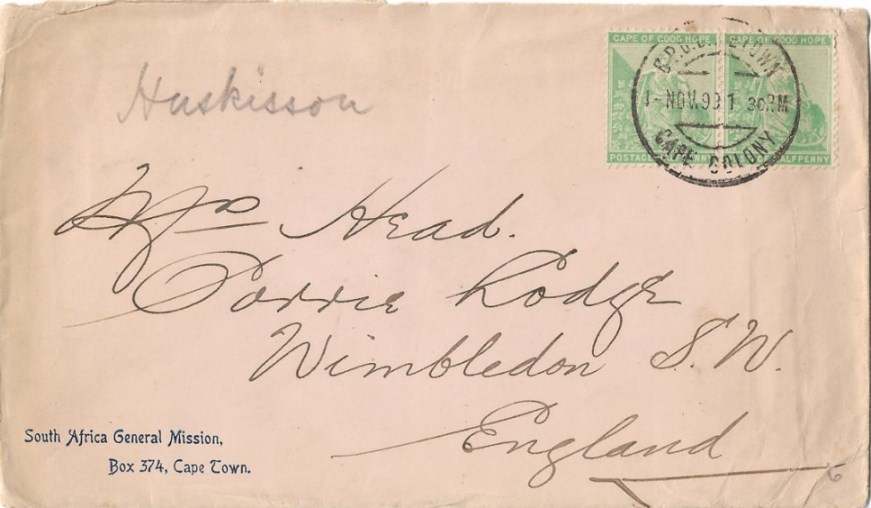
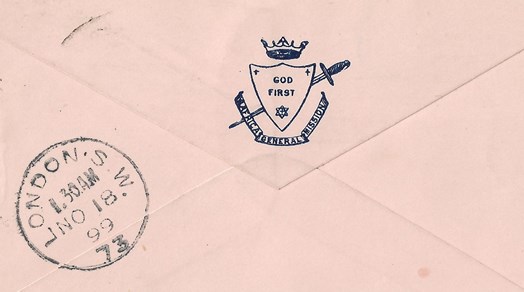
Figure 3 The cover (envelope) is addressed to 'Mrs. Head, Corrie Lodge, Wimbledon S.W., England' entered the post in Cape Town on the 1st November 1899. The envelope has the sender’s postal address printed in blue at bottom left: ‘South Africa General Mission, Box 374, Cape Town.’ The sender’s name, [Frank] Huskisson15a, has been annotated in pencil at top left by Mrs. Head on arrival. It was common for people and businesses to file letters in the envelope for future reference. The motif on the back-flap is also printed in blue.
The following is an extract from a circular letter written by Caroline in January 1898:
“I have had such a number of welcome and interesting letters and loving remembrances from many of
you in different parts of the world this Christmas time. From China, Smyrna, Switzerland, Denmark,
Sweden, Spain, America, North Africa and specially many of you in South Africa.” 16
By October 1899 it was felt that the four rooms, used as an office by the SAGM, at 14a Lingfield Road had become cramped and larger premises were found at 17 Homefield Road, Wimbledon.
At the time of the 1901 Census17 in addition to Albert and Caroline Head, there were three visitors at Corrie Lodge. All three names have been found annotated by Mrs. Head on covers which were sent to her from South Africa).
Abbie Park Ferguson, Single, age 63, President of College, born United States of America, British subject.
Helen Murray, Single, age 51, Principal of Seminary, born Cape Colony, British subject.
Emmie Maria Murray, Single, age 43, Officer Salvation Army, 'born Orange River Colony' [Orange Free State], British subject.18
The household staff consisted of: Cook, Parlour Maid, House Maid and Kitchen Maid.
Miss. Abbie Park Ferguson.
After graduating in 1856 from Mount Holyoke Female Seminary, Massachusetts, Abbie taught in America before travelling to Paris to teach, where she became caught up in the Franco-Prussian War. She returned to Connecticut to work in city missions and in 1873, at the invitation of Rev. Andrew Murray, sailed to Cape Colony where in the following year she founded the Huguenot Seminary in Wellington, the first institution of higher learning for women in the country, which in 1898 became a college with Ferguson as President.23, 25
Miss. Helen Murray.24
Daughter of Rev. Andrew Murray (Snr.), Helen graduated from the Huguenot Seminary in 1875 and from 1876 - 1916 was Principal of the Midland Seminary at Graaff Reinet, Cape Colony. She wrote an autobiography The Joy of Service published in 1935.25
Subsequent to the visit Miss. Helen Murray wrote a letter of thanks.19
“April 6th, 1901. I do not know how to thank you for your kindness, or how to let you know what a pleasure my Wimbledon visit was. As I look back, every hour of the time was perfect enjoyment – your and Mr. Head’s thoughtful love and kindness, your beautiful home, the joy of Christian fellowship, the warm welcome after the coldness of life on the steamer, the Sunday services, the fields and flowers, all combined to make the first two days in England perfect. I shall always look back to that little visit with pleasure and remember the many bits that made up the whole ... Such enjoyment is life-enjoyment, and does not end when the visit is over ...”
Carrie and Albert Head also received SAGM friends at their country residence, Bury Hill, in the Anna Valley near Andover, where their Son, Alfred lived.19a
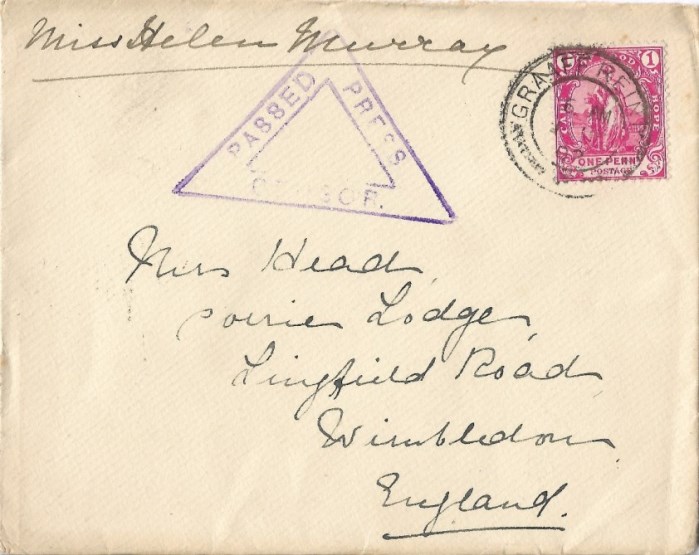
in Wimbledon on the 22nd March 1902. As it was posted during the South African War, ordinary mail
was accepted subject to censorship. The triangular censor handstamp has been struck in purple ink.
On Thursday the 20th October 1904, Caroline Head addressed a large meeting, on her theme of "Praise", at Morley Hall in London. The next day she was unwell, nevertheless it was not thought serious. However, it rapidly turned worse and despite loving and skilful attention, Caroline Head died on the 26th October 1904, age 51.
 Figure 5
Mrs. Caroline Head.
Figure 5
Mrs. Caroline Head.
She is buried at Richmond Cemetery.20 Among the 700 letters of condolence, is one from Miss. Abbie Park Ferguson, of the Huguenot Seminary, Wellington, Cape Colony21
“I am continually reminded of my arrival four years ago with Miss. Murray, and the wonderful, loving reception you and Mrs. Head gave us on the day of our arrival. It seemed like a bit of heaven let down to earth, and now your beloved one has entered upon the joy of heaven itself, and for her we are glad; but oh! How we miss her. England does not seem the same country without her dear face to bid us welcome.”
To W. Spencer Walton and his wife, Lena (née Gibson), who were in North America, raising funds for the SAGM, the sad news of Mrs. Head's demise came as a shock, as they had visited Caroline and Albert Head at Bury Hill the previous July. They wrote from Canada.
"November 7. We heard to-day of dear Mrs. Head's sudden removal. Very much upset and broken down, both of us feeling it keenly. She was one of our dearest friends, and we loved her dearly. I have never met a more lovely character, nor one who showed more of the sweet spirit of her Master. Our hearts go out to beloved Mr. Head ! Our prayers go up for him. This has indeed saddened us."
The Mission work carried on and the Waltons' were to meet with Albert Head during 1905, at Conventions and Mission meetings at Keswick, Wimbledon and in the Walton's home town of Tonbridge, where Albert: 'At the evening meeting ... gave a most helpful address to a crowded and attentive audience.'
Mr. Head remarried21a in 1907, and continued his Christian philanthropic work with his new wife. He died in October 1928, and among the hundreds who attended the funeral service at Emmanuel Church, Wimbledon and interment at Richmond Cemetery was Miss. F. Georgina Gabb.22
Mission Stations in Swazieland
According to Du Plessis, previous attempts to establish missions in Swazieland by Berlin and Wesleyan Societies “had met with disappointment and disaster”. The only Christians to gain a foothold were “a Church of England missionary, a Wesleyan native minister and a Salvation Army Captain”.26
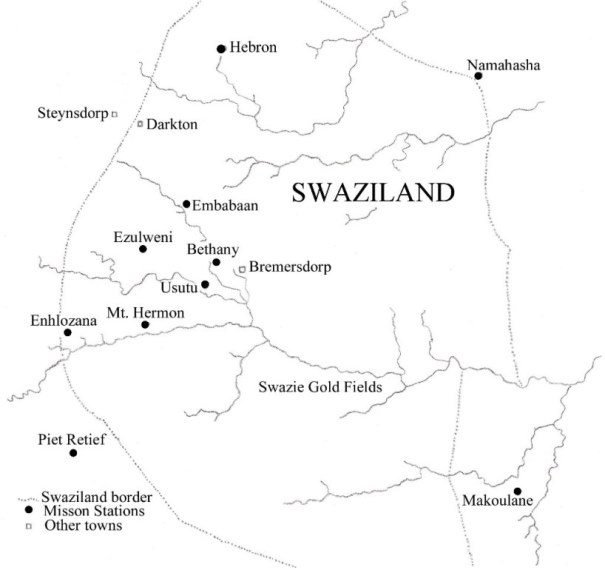
The spelling conforms to that used in the Statistical Atlas of Christian Missions.27
On a visit to Cape Colony in 1888, William Spencer Walton obtained approval and support from the people there for his proposal to expand missions in southern Africa and on the way back to England, whilst studying a map of Swazieland he decided to help the “thousands of heathen” in that “neglected country”. He discussed his proposals with Christian friends in England and formed The Cape General Mission on the 12th March, 1889, with Albert Head on the Council.28
The Cape General Mission in Swazieland.
Mr. John Baillie and his wife founded the Bethany Mission station, eight miles from Bremersdorp, during 1891. Following difficulty with the local Headman they travelled to see Theophilus Shepstone (Jnr.) to authenticate permission to stay. He told them that “legally they had every right to stay where they were, but that he feared the headman’s influence [would] utterly prevent any natives from attending the services.”29 Their “shanty” was of mud with a corrugated iron roof, into which snakes, which included deadly Puff-Adders, found their way.30 In 1893 the South African Pioneer reported “I doubt if there are a dozen real genuine Swazie Christians in the whole nation ... There is still ‘smelling out’ going on.”31 The Swazi were of the same branch of the Bantu Race as the Zulus, they also overlapped the borders residing in Eastern and South Eastern districts of the South African Republic (Transvaal).32 The aim of the Mission was to increase the presence of missionary workers in Swazieland using Bethany station as a base. Funds for this endeavour were sought from generous benefactors.
Miss. Clara Harris and Miss. F. Georgina Gabb.
Clara Harris and Georgina Gabb (born Sussex 1854) travelled to Africa with Mr. Michael H. Coates and lived in Pretoria for a year where Harris and Gabb learned siZulu.33 A year and a day after their arrival at the Cape, Clara Harris, Georgina Gabb and Mr. and Mrs. Rhoda Coates left Pretoria for Swazieland saying goodbye to Caroline and Albert Head on the 9th November 1893 and to other friends, on the outskirts of Pretoria the following day. The journey began well but after two weeks they were only half way. Then the rain came; Miss. Harris notes that they were soon “with mud up to the axle-trees, wagon unloaded, screw cranks applied ... engage another wagon and divide the load.” Undaunted; “God ... keeps us wonderfully happy and bright.” On the 22nd November “while outspanned, we come across over 100 raw ... natives, on their way to Johannesburg, and were able to have a service for them. They clustered round us squatting on the ground, in various grotesque costumes, dress and undress”. They sang hymns and the Christian boys who journeyed from Pretoria told them the “old, old story.” During their journey they called on farms, where Mrs. Rhoda Coates was able to converse with the Boer families. Occasionally, as on the 24th November, they found one member of a farming family who could speak English.34 On Wednesday 3rd December they crossed the Swazieland boundary and knelt to pray, claiming “Swazieland for Jesus” and on arriving at Bethany were given a warm welcome by Mr. and Mrs. Baillie.35
Bethany.
Mr. Coates’ knowledge of medicine was most useful in helping the “suffering Swazis”, and soon established him in favour with the Swazi Queen. Bethany mission station was sparse, Clara Harris and Georgina Gabb’s accommodation had no windows and the door was only three feet in height so on rainy days they sat on the floor writing by the door for need of light. When the Children came they were often very dirty and soap was provided for them to wash in the river. However, there was no money for quinine “our poor native boy in our employ has died ...”. When the flag was raised the “Natives” came for services even when it rained “Some had walked five miles, one girl had swum across the swollen river”. Clara and Georgina were often working separately36 as they travelled to other out-stations, one of which was twelve miles from Bethany. The services were normally in three languages; “prayers went up to God in English, Dutch and Zulu”.
Other Mission Stations.
Clara Harris and Georgina Gabb founded the Hebron mission one year after starting missionary work at Bethany. Hebron, about 30 miles North of Bethany, was a healthy site where the missionaries could escape from the low valleys where they suffered from relapsing fever which carried off two of their children. There was also an out-station called “Welcome”.* For nine weeks they lived in a native hut before their log [sod?] cabin with mud floor and thatched roof was built; items such as doors and windows were brought from Delagoa Bay.37 Following the appointment of a ZAR Resident Special Commissioner the Mission Station was abandoned for a while during 1895 in case the Swazis chose to fight.38
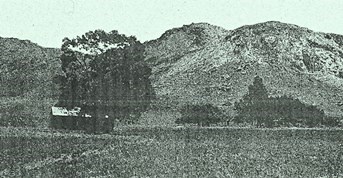
The Church at Hebron Mission Station
During December 1897 Clara Harris with Miss. Mary Peake-Brown founded the Ezulwini mission station about 12 miles from Bethany. As donations from around the world arrived, churches, schools, mission halls and dwelling houses were built. Caroline and Albert Head were among those who contributed, they also supplied pictures for the walls of churches including Hebron and “a beautiful little stove” for Miss. Gabb.39 Even the church bell at Bethany was the old bell from Emmanuel Church, Ridgway, Wimbledon, where Caroline and Albert were prominent members.
Deserted Missions.
Following the troubles of May, June 1898 when the Swazi King, Bhunu, was summoned to court; missionary work was temporarily suspended. Those not on furlough mostly went to Piet Retief, although Mr. Coates was reported to have been vigilant at both Hebron and Bethany. Once the King had fled the country, all returned to their stations by October.40
With the prospect of a War between Britain and the Republics in southern Africa, 1,100 refugees from the South African Republic and Orange Free State arrived at Durban, Natal, in forty-eight hours on the 12th of September 1899.
The first SAGM missionaries to be removed, were from the Natal border mission station at Ingogo.40a However, the missionaries in Swazieland, which was a protectorate of the South Africa Republic, at first did not know what to do, and there were some goings and comings. In Durban W. Spencer Walton prayed for guidance. Shortly, a member of the Cape Colony Legislative Assembly, telegraphed Walton to say ‘Advise missionaries withdraw quickly’. If they had stayed, their oxen and waggons would have been commandeered by the Boers of the two Republics, which would have meant total isolation from all supplies, and communication with the outside world.
All four SAGM stations in Swazieland were abandoned, and the missionaries and their families, reached Portuguese territory, just an hour before it was known that war had been declared on the 11th October 1899. They encamped in the Lebombo Mountains, before Messrs. Baillie and Gale escorted their fellow SAGM comrades to the coast at Lorenzo Marqués. ‘The town was crammed with refugees who were pouring in, men, women and children.’ Moreover, the South African Republic had turned men out of their gaols and it was ‘awful to see the amount of drunkenness’. It took all day for the missionaries and their families to find sleeping accommodation and food.40b
In 1901 they were given permission to return but the High Commissioner was unable to offer any protection. It was not until the British had assumed authority41 that missionaries were able to resume their work. John Baillie crossed from the Portuguese East Africa border on 1st July 1902 and reached Bremersdorp on the 3rd where he found “All the principal houses, hotel, post office, Court-house ... are burnt to the ground.” Towards sunset he arrived at Bethany and during the next few days was able to gauge the effect of war on the mission buildings. Mt. Hermon was the only station destroyed (by Boer and British forces). At Bethany the buildings although looted were standing undamaged except for the “ravages of white ants and weather”. Ezulwini and Hebron Stations remained untouched. Most of the 'Christian natives' left in charge remained faithful and had continued with the work. Clara Harris returned from Charlestown, Natal42 to Ezulwini and later started a Mission Station in Mbabane.43
Conclusion.
The bulk of Caroline Head’s mail was generated by her interest in the SAGM/CGM and in particular with the women missionaries, known as “workers”, who received her support and encouragement. In Swazieland these “workers” frequently moved from one mission station to another.
It would appear that covers emanating from Hebron were cancelled at Darkton. Research has established that F. Georgina Gabb was at Darkton Post Office on 23rd August 1894 where she wrote and posted a letter, which was later reported in the South African Pioneer.52 It is thought that someone from the Hebron Mission went to Darkton at least once a month to post/collect mail and purchase provisions. The covers from Ezulwini were possibly all cancelled at Embabaan. The cover cancelled at Embabaan on 9th December, 1897, from Clara S. Harris is in all probability the first addressed to Mrs. Head that originated from Ezulwini, as Clara did not start the mission station until that month. The post offices where the datestamps were applied are almost certainly the places where the covers first entered the post.
The ZAR (South African Republic) stamps overprinted “SWAZIELAND” were invalidated from 7th November 1894 which would imply they were taken out of use some time before that date. ZAR stamps without the overprint, cancelled in Swazieland, are to be found dated from late December 1892, 53 which was just over a year after the building of Bethany Mission station (probably June 1891). It is therefore just possible that “Mrs. Head” covers could be found used with the overprinted stamps.
Apart from the periods when the missionaries left Swazieland for their own safety, there was regular mail to Wimbledon. There were reports most months from Swazieland published in the South African Pioneer from at least 1893 and thereafter often from more than one station. After 1904 these reports were possibly addressed to the editor, William Spencer Walton at the SAGM office or to his home in Tonbridge, although some may have been sent via Caroline. Research indicates that there was an enormous amount of mail addressed to “Mrs. Head” much of it from southern Africa and there are bound to be more ‘sleeping’ covers lingering in collections. It is hoped that we will be able to add to our knowledge by reporting descriptions of other covers addressed to Mrs. Head including details of any annotations.
Postscript.
George E. Weeks writing about W. Spencer Walton wrote the following.54
‘He arrived in Capetown [September 1889] in the early days of the Cape General Mission with half a dozen workers; he sailed in 1904 rejoicing that its field of operations now extended from Cape Point to Port Herald (on the Zambesi), with stations in such remote districts as Bomvanaland, Pondoland and Gazaland, while the handful of workers had become an army numbering nearly a hundred.’
* - see the Link to 'Daniel' below for update on the out-station.
Acknowledgements.
We thank, Sarah Gould, Heritage Officer, London Borough of Merton Library & Heritage Service for supplying photocopies of Wimbledon newspapers and for the photograph of Corrie Lodge (the photograph is not used here), The British Library Board for photocopies of Mrs. Head, Miss. Ferguson and Miss. Murray (the photocopies are not used here), Library of the London School of Economics and Political Science for photocopies from the Statistical Atlas of Christian Missions, Bryan Goodwin, Reference Librarian, Mount Holyoke College, Massachusetts for website information. Also, a special thanks to Andrew Higson and the late Joan Matthews for much information and advice.
Notes and References.
1 (1905), Life of Mrs Albert Head.
2 To at least 1905 The South Africa General Mission used the Dutch spelling “Swazieland” which has been used here throughout, except for the map. 3 Sunnyside, Richmond Hill, Surrey.
4 Hanbury, (1905), p.137-141.
5 Andover Advertiser, 13th July, 1917.
6 The Cape General Mission was founded on the 12th March 1889, and from this organization, The English Council arranged to amalgamated the Cape General Mission with the Southeast Africa Evangelistic Mission to establish The South Africa General Mission. William Spencer Walton returned to South Africa in September 1894, accompanied by three new workers, to start a new chapter in their mission. 7 (1910), Statistical atlas of Christian missions, containing a directory of missionary societies, a classified summary of statistics, an index of mission stations, and a series of maps, p.45. 8 Hanbury, (1905), p.148, passim; also for her endeavours in North London - see: Mildmay.
9 Walton, W.S., (1889) Cape General Mission, South Africa, England. [ British Library; Shelfmark 4766.a.17.(3.) ].
10 Hanbury, (1905), p.150.
11 South African Pioneer, Vol.vii, No.3, March 1894.
12 Hanbury, (1905), p.153-154. [Michael Hunter (Macecebuka) Coates and his wife, Rhoda, were in Swazieland during 1889].
13 Hanbury, (1905), pp.155-163.
14 South African Pioneer, Vol.x, No.5, May 1897.
15 South African Pioneer, Vol.x, No.9, September 1897.
15a As the SAGM expanded in southern Africa changes were made to the administration. In September 1895 Huskisson andMr. Dudly Kidd became responsible for Supervision of the Northern Branch. Less than five years later, January 1900, with the country plunged into the horrors of war, Huskisson with Mr. Darrall setup ‘Soldiers Homes’ at Modder River and De Aar. They rendered help in the fighting line assisting the wounded, and ministering to their physical and spiritual relief - see Weeks, (1907), pp.94, 112. 16 Hanbury, (1905), p.189.
17 1901 Census Returns for England and Wales.
18 Du Plessis, (1920), pp.331, 487, plate facing 488. Emmie was the eldest Daughter of Andrew Murray (Jnr.), and was teaching in Pretoria at the outset of the First Anglo Boer War. She severed links with the Salvation Army in 1902 to work for an organization to help women. 19 Hanbury, (1905), p.272.
19a Weeks, G.E., (1907), p.150, 153-154
20 Wimbledon News, 5th November, 1904, p.8, and 29th October, 1904, p.1.
21 Hanbury, (1905), p.286.
21a Miss Elizabeth (Bessie) Ann Porter had been Secretary of the Swansea Young Women's Christian Association. Later she was a member of the South Africa General Mission and sailed to Africa on the 6th November 1897; where she worked in ‘Cape Town, Village Work’. Albert Alfred Head married Elizabeth Ann Porter, known as Bessie Porter on the 17th December 1907, who after her marriage, styled herself as Bessie Porter Head. Albert Head died during 1928 and Bessie Porter Head moved to the SAGM house at Wimbledon until her death on 28th June 1936. 22 Wimbledon Borough News, 2nd November, 1928, p.2 and the 9th November, 1928, p.2. On the 17th December 1907
23 Ferguson Papers, 1861-1919.
24 A picture of the Murray Family taken in 1873 can be found in Du Plessis, J., (1920), facing p.281, Helen Murray is standing on the left.
25 Photographs - see Ferguson, G. P., (1927).
26 Du Plessis, (1920), p.386.
27 (1910) Statistical atlas of Christian missions, containing a directory of missionary societies, a classified summary of statistics, an index of mission stations, and a series of maps, plate 6. Here Bethany is shown to the west of the river although on sheet “6” of Jeppe’s 1899 map of the “S[outh] A[frican] Republic”, Bethany described as “African General Mission” is shown to the east of the “Kl Usutu Riv” (Little Usutu River). 28 Weeks, (1907), pp.46, 51.
29 Weeks, (1907), pp.63-64.
Frizen, E. L. (Jr.), (1992), p.160, records that the first Cape General Mission Station in Swazieland was opened in June of 1891.
30 South African Pioneer, Vol. vi, No.1, January, 1893.
31 South African Pioneer, Vol. vi, No.9, September, 1893.
32 Results of a census of the Transvaal Colony and Swaziland, p.xii; see also: Christopher, (1982), pp.25, 27.
33 Jones, (1993), p.244.
34 South African Pioneer, Vol. vi, No.12, December, 1893.
35 South African Pioneer, Vol. vii, No.2, February, 1894.
36 South African Pioneer, Vol. vii, No.3, March 1894, Vol. viiii, No.4, April, 1895.
37 South African Pioneer, Vol. vii, No.11, November 1894; Vol. vii, No.12, December 1894.
38 South African Pioneer, Vol. viii, No.11, November, 1895.
39 South African Pioneer, Vol. x, No.2, February, 1897.
40 South African Pioneer, Vol. xi, No.8, August, 1898, Vol. xi, No.9, September, 1898, Vol. xi, No.11, November, 1898; see also Jones, (1993), p.xxxiv. 40a Ingogo was in Natal close to the Orange Free State border and just south of Volksrust in the South African Republic.
40b Weeks, (1907), pp.108-110.
41 Stone, J.C., (1995), p.302.
42 South African Pioneer, Vol.xv, No.9, September, 1902; Vol. xv, No.10, October, 1902; Vol. xv, No.11, November, 1902.
43 Jones, (1993), p.270.
44 The Transvaal Philatelist, Vol. 34, No.2 (130), May 1999, p.58.
45 The Transvaal Philatelist, Vol. 44, No.3 (171), August 2009, p.51.
46 The Transvaal Philatelist, Vol. 44, No.4 (172), November, 2009, p.93.
47 Idem.
48 The “Mrs Head” correspondence (2), The Transvaal Philatelist, Vol. 45, No.1 (173), February, 2010, p.10.
49 The “Mrs Head” correspondence (1), The Transvaal Philatelist, Vol. 45, No.1 (173), February, 2010, p.10.
50 Goldblatt, R., (1983).
51 There was a ‘worker’ named Daniel in Swazieland during the 1890s and Mr. and Mrs. Head took a particular interest in a mission station in Pondoland named ‘Daniel’. [However, please see the article 'Daniel' below.] 52 South African Pioneer, Vol. vii, No.10, October 1894.
53 Higson, A., (1999), pp.passim.
54 Weeks, (1907), pp.42, 145.
Bibliography.
Christopher, A.J., (1982), South Africa, London.Du Plessis, J., (1920), The Life of Andrew Murray of South Africa, London.Ferguson, G. P., (1927), The Builders of Huguenot, Cape Town.Ferguson Papers, 1861-1919. http://asteria.fivecolleges.edu/findaids/mountholyoke/mshm107.htmlFrizen, E. L. (Jr), (1992), 75 years of IFMA, 1917-1992: the Nondenominational Missions Movement, Wheaton, Illinois.Goldblatt R., (1983), Postmarks of the Cape of Good Hope, Cape Town.Hanbury, C., (1905), Life of Mrs. Albert Head, London [Charlotte Hanbury of the Church of England Zenana Missionary Society was a Sister of Mrs. Head].Higson, A., (1999), Some reflections on the early stamps and postal history of Swaziland; politics, passion and plague, The Transvaal Philatelist, Vol. 34, No.1 (129), February. Higson, A., (2009), Darkton, 1895, The Transvaal Philatelist, Vol.44, No.3 (171), p.51.Mildmay, www.british-history.ac.uk/report.aspx?compid=5195 (Active 2010 - 2021).Murray, H., (1935), The Joy of Service, [An autobiography], London & Edinburgh.Jeppe, F., (1899), Map of the S[outh] A[frican] Republic.Jones, H. M., (1993), A Biographical Register of Swaziland to 1902, Pietermaritzburg.Results of a census of the Transvaal Colony and Swaziland taken on the night of Sunday the 17 April, 1904. Presented to His Excellency the Lieutenant-Governor, May 1906, London. South Africa General Mission, (1889), Cape General Mission, South Africa, [Wimbledon]. [An account of its foundation by W.S. Walton]. [ The copy consulted by the authors is lodged with the British Library, London. “Shelfmark”, 4766a.17.(3.) ] South African Pioneer, Vol. vi, No.1, January 1893 to Vol. xv, No.12, December, 1902. Editor W.S. Walton (d.1906). [From 1893 referred to as “OFFICIAL ORGAN OF THE SOUTH CAPE GENERAL MISSION”, from 1894 as “ORGAN OF THE SOUTH AFRICA GENERAL MISSION” and from 1896 as “THE OFFICIAL ORGAN OF THE SOUTH AFRICA GENERAL MISSION”]. Stone J.C., (1995), "The Cartography of Colonialism and Decolonisation", pp.298-313, in Geography and Imperialism 1820-1940, Manchester University Press.Statistical atlas of Christian missions, containing a directory of missionary societies, a classified summary of statistics, an index of mission stations, and a series of maps.(1910). [The copy consulted by the authors is lodged with The Library of the London School of Economics and Political Science.] The Transvaal Philatelist, England.Transvaal Study Circle, www.transvaal.org.uk/swaziland.html. Ative to April 2020.Walton, W.S., (1889), Cape General Mission, South Africa, England.Weeks, Rev. G.E., MA, BD, (1907), W. Spencer Walton, "Approved of God to be intrusted with the Gospel", London.Woolgar, J., (2010), The "Mrs. Head" correspondence, The Transvaal Philatelist, Vol.45, No.3 (176), November 2010, pp.83-94, England.Newspapers
Andover Advertiser.Wimbledon Borough News.Wimbledon NewsPublished since 2011
Higson, A., Stone, A., and Woolgar, J., (2016), A further "Mrs Head" Cover, The Transvaal Philatelist, Vol.51 (193) March 2016, pp.25-26.Woolgar, J., and Stone, A., (2019), The "Mrs. Head" correspondence, revisited - Daniel, The Transvaal Philatelist, Vol.54, No.3 (204) November 2019, p.85, England. Woolgar, J., and Stone, A., (2020), South African General Mission - Eva L. Carmichael. published by Woolgar, England, and first published on this website, 5th June 2020.
-- List of Mrs Head covers from Africa --
-- Daniel" --
-- Back to Home page. --
Copyright © 2020, 2021, 2022 A. Stone & J. Woolgar - - o - -